Imagine a perfect garden where vibrant blooms are long-lasting, low-maintenance, and pest-resistant. In frost-free climates, annual flowering plants act like perennials, continuing to blossom for multiple seasons.
You’ve just imagined a world of marigolds.
These striking flowers come from Central America, particularly Mexico, where they’ve been cultivated for centuries. They hold cultural significance in festivals like Mexico’s Día de los Muertos and India’s Diwali. They’re incredibly versatile, growing in a wide range of climates and conditions.
Marigold Varieties
Popular types of marigolds include:
- French Marigolds (Tagetes patula): Compact and bushy with smaller blooms, they’re ideal for small beds and containers.
- African Marigolds (Tagetes erecta): Taller and showier, they can grow up to 3 feet, making them a great backdrop for garden beds.
- Signet Marigolds (Tagetes tenuifolia): These have feathery foliage and edible petals and are often grown for culinary and ornamental use.
- Triploid Marigolds: Hybrid varieties with larger blooms and longer flowering periods are often used in commercial productions or for cut flowers.
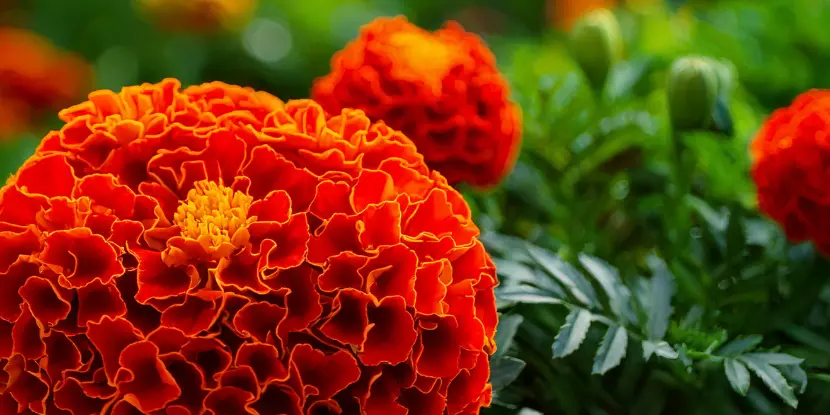
African Marigolds (Tagetes erecta) bear showy flowers and can grow up to 3 feet.
Marigold as Companion Plants
A companion plant is grown alongside other plants for mutual benefit. Certain plants can enhance growth, deter pests, improve flavor, or provide other advantages to their neighbors.
Marigolds repel common garden pests like nematodes, aphids, and whiteflies. Plant them next to tomatoes, cucumbers, peppers, or eggplants to protect your vegetables from unwanted visitors.
Ideal Growing Conditions
Marigolds are remarkably undemanding but will produce the best blooms in optimal conditions.
Light
- They need at least 6–8 hours of direct sunlight daily.
- They can tolerate some shade, but too little sunlight will result in fewer blooms and leggier plants.
- Place them near a south-facing window or provide artificial lighting if growing indoors.
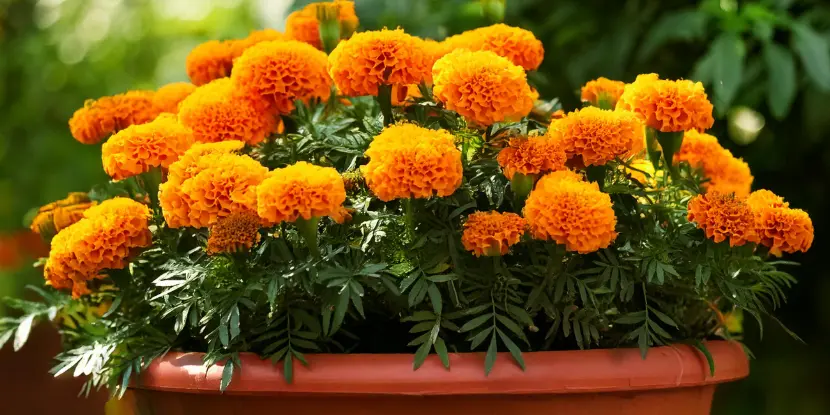
Orange marigolds growing in a pot.
Temperature
- Marigolds thrive in temperatures between 70°F and 75°F.
- They’re sensitive to frost, so plant them outdoors after the last frost has passed.
Soil
- Marigolds prefer well-draining soil that’s slightly acidic (pH 6.0–7.0).
- They can grow in poor soils, but adding organic matter like compost will promote healthier plants and bigger blooms.
- Avoid overcrowding, which can lead to fungal diseases.
Planting Marigolds
When to Plant
- Start seeds indoors 4–6 weeks before the last expected frost, or
- Directly sow seeds outdoors once the soil is warm and frost-free.
Steps for Planting
- Loosen the soil in your garden bed, or choose a container with good drainage.
- Scatter seeds directly on the soil surface and lightly cover them with a thin layer of soil (1/4 inch or less).
- Use a watering can or spray bottle to moisten the soil without washing away the seeds.
- Ideally, keep the soil temperature around 70°F. Using a seed-starting heat mat indoors can help.
- Marigold seeds typically germinate within 4–14 days.
- Thin your seedlings once they reach 1–2 inches tall, leaving 6–18 inches of space between each plant (depending on the variety).
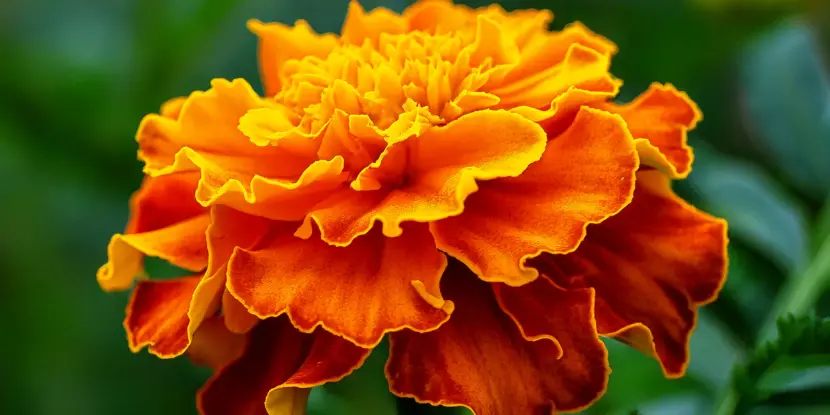
Triploid Marigolds have larger blooms and longer flowering periods.
Marigold Care
Marigolds are low-maintenance plants. However, the only no-maintenance plants on Planet Earth are the plastic variety.
Watering & Fertilizing
- Keep the soil moist but not soggy.
- During hot, dry spells, increase watering frequency to prevent wilting.
- Feed with a balanced fertilizer once a month, following package instructions.
- Too much nitrogen can result in fewer blooms and more foliage growth.
Pests & Diseases
Marigolds are naturally pest-resistant. Still, they’re not immune.
- Aphids or spider mites: Spray plants with water or apply mild insecticidal soap to remove them.
- Powdery mildew occurs in damp conditions. Provide good air circulation and avoid wetting the foliage.
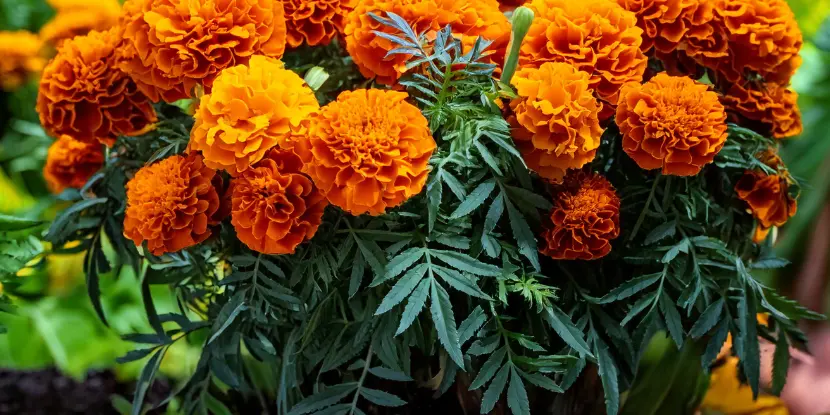
Marigolds make excellent container plants for indoor or outdoor cultivation.
Growing Marigolds in Containers
Marigolds adapt well to containers, making them an excellent choice for patios and balconies.
- Choose a pot at least 8–12 inches deep. It should have drainage holes.
- Use a potting mix with good drainage.
- Position your container in full sun and water regularly to ensure the soil doesn’t dry too quickly.
Extending the Blooming Season
- Deadheading, or removing spent blooms, can prolong the flowering period.
- Pinch off wilted flowers at their base to encourage bud formation.
- Alternatively, leave some spent blooms on the plant and wait for them to produce seeds for next season’s planting.
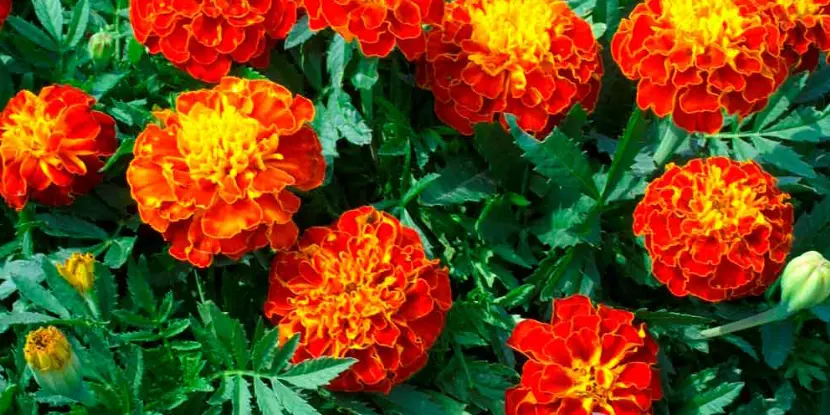
French Marigolds (Tagetes patula) are compact and bushy with smaller blooms.
FAQs: Growing Marigolds
Q: How long do marigolds take to grow from seed?
Depending on the variety, marigolds typically take 8–10 weeks from seed to bloom.
Q: Can I grow marigolds indoors?
Yes, marigolds can grow indoors as long as they receive sufficient sunlight. Place them near a bright window or use grow lights.
Q: How long do marigolds bloom?
Marigolds bloom continuously from late spring until the first frost if deadheaded regularly.
Q: Are marigolds safe for pets?
While not highly toxic, they can cause mild gastrointestinal discomfort in pets if ingested. Keep them out of reach just to be safe.
Q: Do marigolds come back every year?
Most marigolds are annuals, meaning they complete their life cycle in one growing season. However, they often self-seed, and new plants may appear the following year.
Q: Can marigolds grow in poor soil?
Yes, marigolds are known for their ability to grow in poor soils. However, adding organic matter like compost will improve plant health and encourage more vibrant blooms.
Q: How do I prevent marigolds from becoming leggy?
Ensure marigolds receive at least 6–8 hours of full sunlight daily. Regularly pinching back growth and avoiding over-fertilizing can also help maintain a compact, bushy shape.
Q: Why are my marigold leaves turning yellow?
Yellowing leaves can indicate overwatering, poor drainage, or nutrient deficiencies. To improve plant health, ensure your soil drains well, reduce watering if it’s overly damp, and consider applying a balanced fertilizer.

